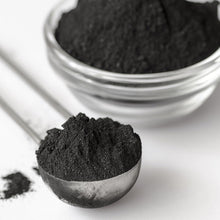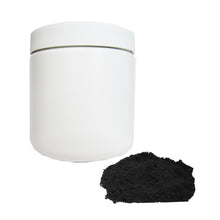Info: 150 Gram Jar
Activated charcoal is often used to help relieve digestive upsets like excess gas, where some prefer to take relatively small quantities of activated charcoal in capsule form. However, there are several applications where much larger or variable quantities of a high quality 'loose' powder like this are required, such as treating overdoses, or creating wound dressings or oral or facial cleansers (or creams, pastes, or masks).
Info: 150 Gram Jar
Activated charcoal is often used to help relieve digestive upsets like excess gas, where some prefer to take relatively small quantities of activated charcoal in capsule form. However, there are several applications where much larger or variable quantities of a high quality 'loose' powder like this are required, such as treating overdoses, or creating wound dressings or oral or facial cleansers (or creams, pastes, or masks).
Product Notes:
Activated charcoal (or carbon) is produced by super-heating materials like hard wood or coconut shells along with oxygen or CO2 or other gases or activating agents to expand its amount of porous surface area to bind with various toxins it might come into contact with – which either get trapped there and ultimately discarded (when it's functioning within a water or air filter or as part of a topical cleanser), or defecated (if it's been ingested).
Activated charcoal also has commercial uses, such as for purifying or decolorizing medications and foods (including sugars and mineral or cooking oils).
Apart from filtration, one of its most important home uses is as a general purpose antidote for oral poisoning, but increasingly it's also commonly found in a range of personal care products such as soaps, toothpastes, or facial creams or masks, as well as in wound dressings for chronic wounds such as pressure ulcers (bedsores).
Related Products: Also see Charcoal Facial Detox Soap and Living Clay calcium bentonite powder.
Sourcing and Characteristics:
This Activated Coconut Charcoal Powder is made from raw, unprocessed food-grade coconut shells grown in Mexico. After undergoing the relevant cleansing, purification, and activation procedures, it is then put through a size 325 Mesh, to product an Ultra Fine powder.
To get an indication of its absorbent (or technically, adsorbent, since it doesn't just take up but actually binds) capacity, the customary method in this domain is to use the “iodine value” scale, as a proxy for how large its available surface area is, compared to similar products.
This involves a lab test to see how much iodine can gets absorbed by 100 grams of the substance, with the results being standardized to X milligrams of Iodine per gram of the test product. In this case, it's at least 1,100 mg/g, which is near the top of the scale (which ranges from 500 to 1,200 mg/g for various types of activated charcoal, with the lower values in the 5 to 700 range being for charcoal produced from inferior materials such as straw or actual coal).
Suggested Usage:
For non-overdose-related internal purposes, our supplier recommends a 1/2 teaspoon serving, mixed with water, taken at least an hour before or after ingesting any food, supplements, or medications (so as not to interfere with their absorption and efficacy).
For an actual event of acute poisoning (by an overdose of a whole bottle of Tylenol, e.g., or accidentally taking too many beta-blocker pills for high blood pressure), try contacting a poison control center or emergency medical facility first before attempting to manage the situation, but in a pinch, some sources indicate a standard dose for an adult is 25 to 100 g in about 250 ml of water (although a recent study found subjects find it more palatable when mixed into apple juice, instead).
Stir it in well until a uniform 'slurry' (where the solids are suspended in equal concentrations throughout the liquid) is formed, then drink it as soon as possible (over a 15 minute period, if possible, sipping it like a drink, to spread it out more).
It's most effective when taken within 30 minutes of the event, and is a lot less so after an hour, for some substances (although it can still be effective for up to four hours later for the tricyclic types of antidepressants). But because it has been shown to have secondary effects (not just passively adsorbing what it bumps into in the intestines but also promoting excretion), there can be benefits to multiple doses, which might be indicated when the poisoning was due to injected drugs.
Activated Charcoal does not help with all types of oral poisoning, however: particularly not those caused by corrosive agents, cyanide, iron, mineral acids, or organic solvents. It is also unlikely to help with alcohol poisoning.
Warnings:
Do not take activated charcoal within two hours of taking other medications, since it may adsorb them and reduce their effect. Do not combine with drugs or herbs used for constipation. Do not administer to children under the age of 12 except with doctor approval. Consult a healthcare practitioner if symptoms persist or worsen.
Supporting Science:
“A Comprehensive Review of Topical Odor-Controlling Treatment Options for Chronic Wounds.” Journal of Wound, Ostomy, and Continence Nursing, 2016.
“Acetaminophen Poisoning.” Critical Care Clinics, 2021.
“First aid interventions by laypeople for acute oral poisoning.” The Cochrane Database of Systematic Reviews, 2018.
“Reducing infection in chronic leg ulcers with an activated carbon cloth dressing.” British Journal of Nursing (Mark Allen Publishing), 2016.
“Systematic review on the use of activated charcoal for gastrointestinal decontamination following acute oral overdose.” Clinical Toxicology, (Philadelphia, Pa.), 2021.
“The effect of activated charcoal on drug exposure following intravenous administration: A meta-analysis.” Basic & Clinical Pharmacology & Toxicology, 2021.
“The Use of Activated Charcoal to Treat Intoxications.” Deutsches Arzteblatt International, 2019.




